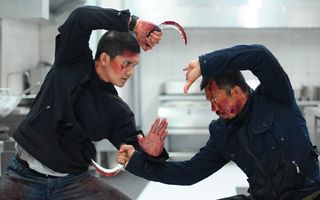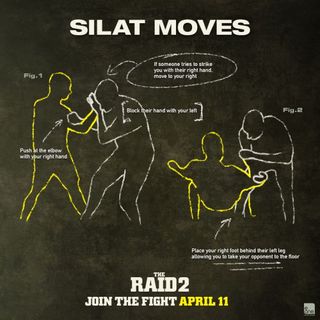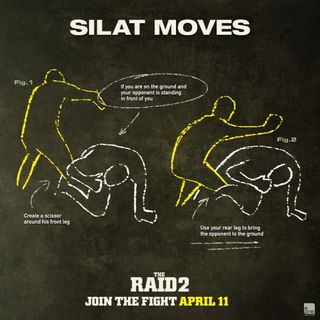The Raid 2: secrets of silat
One of the UK's leading silat fighters talks about the fitness benefits of this beautiful but deadly martial art

Following up his internationally successful Indonesian action film The Raid, director Gareth Evans’s sequel sees original star Iko Uwais and a host of other combat experts throwing down on screen, channeling the brutal fighting styles of pencak silat. MF caught up with trainer Vikram Iyer of the UK’s national pencak silat competition team, who trained with Cecep Arif Rahman – a renowned silat expert and one of The Raid 2’s stars (he plays the curved-knife-wielding antagonist known as ‘The Assassin’) – to find out more about this no-nonsense martial art.
What sets silat apart from other martial arts?
Silat is very tough but there’s always a very strong element of aesthetics in there. If you watch the movie, the fight between Iko and Cecep starts out with them slowly and carefully taking their stances, and that’s very important. It’s one of the nastiest but also best looking martial arts you’ll see and has a very deliberate grace to it, and I think that’s what sets it apart from everything else.
Where did silat come from?
Silat is the name for all the arts of a certain type in Indonesia. The country is made up of thousands of islands and each one had their own kingdom and every kingdom had its own fighting system. They were all designed for the battlefield, so the focus was always on efficiency – it's not about knocking someone out, it’s about taking someone out as quickly as possible and moving onto the next one, whether that’s with weapons or without. In that way it’s quite adaptable to what you’re going to get in a modern situation – the street isn’t a dojo, it doesn’t have nice matted floors or padding. You need to be able to move on unsuitable terrain and respond to your environment, and that’s one of the things silat emphasises.
What level of fitness does silat require?
There is a fitness element to the classes but ultimately we’re here to teach you how to fight, so it’s always geared towards that. How you train outside of the class is up to you. I do a lot of lifting and endurance work but it’s all focused towards making me a better fighter. I do a lot of bag work, skipping and high intensity cardio and I lift heavy – squats, deadlifts, that kind of stuff. I want to be fitter and stronger and make sure no one can dominate me in the ring, so that's how I train. Core work can be helpful for absorbing the impact, but we teach you to take a hit by moving, by shifting your weight and adjusting your defence, so that’s more what we focus on.
What would a typical session entail?
In a typical session you’ll spend 40 minutes or so on technique and bag work, and then the rest of the time doing sparring focused drills. We'd normally wait three to six months before someone new started fighting properly, to make sure they get a solid base in terms of technique. Stretching and flexibility is also extremely important. The first 20 minutes of the class will focus on warming up and dynamic stretching – especially the groin, hamstring, quads, because you want to make sure you can lift and use your legs and move them quickly without anything snapping!
Are there any other benefits?
The number one benefit that silat will give you is confidence – not necessarily that you’re going to go out and get into fights and become some crazy vigilante, but more that you’ll feel like you’ve got something more about you than you had before and that you can hold your ground in a confrontation. That’s especially true in a non-fighting context – a lot of students say that if their manager is pushing them around at work, for example, they feel like they can stand up to them.
You trained with Cecep, one of the stars of the film. How was that?
He’s one of the best performers I’ve ever seen in my life. I went to Indonesia for two months to study at the school he studied at. He was between touring at the time, so for about a week or so he took an interest in me and helped out my training. He showed me how to move my hands faster by keeping them more loose and relaxed, which improved the speed of my punches.
Get the Coach Newsletter
Sign up for workout ideas, training advice, reviews of the latest gear and more.
The fights in The Raid 2 are incredible – is silat really that intense?
Gareth Evans is great at showing how dynamic silat can be. He’s got a real eye for it. In terms of intensity, I’ve never seen fights like that in my life – if I had I’d probably have PTSD! But all the moves are there – if you do know how to use them and you’re in that sort of situation, that sort of fighting isn’t unrealistic. As a showcase for silat I think it’s one of the best ones out there, and he’s done a great job in translating it to the screen.
The Raid 2 is in cinemas on Friday 11 April. If you’re interested in trying silat, get in touch with the Pencak Silat Federation UK for more information. In the meantime, you can find some classic silat moves below...


Richard worked as a features writer in 2013 and 2014 for Men’s Fitness UK, which predated and later shared a website with Coach. Richard went on to a career as a professional journalist and editor, working for brands like Red Bull, Total Film, Den of Geek and others.
